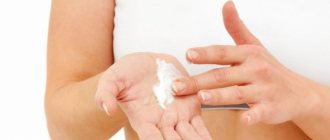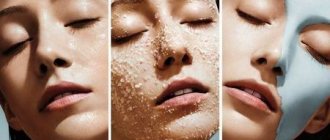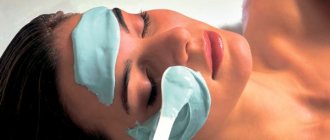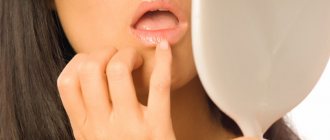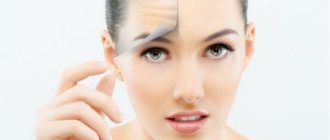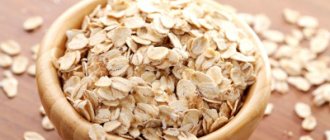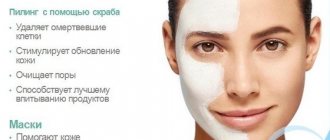Causes of dry skin in babies
According to pediatricians and dermatologists, in the vast majority of cases, dryness on the surface of the baby’s skin is a natural phenomenon that naturally follows from a change in the surrounding microclimate. The newborn's skin has not fully adapted to the air environment after the warm and humid mother's womb.
However, dry and flaky skin in a baby may well be a signal of insufficient care or illness.
Dry baby skin is often a concern for new parents. How to get rid of dryness and flaking of delicate baby skin and prevent this from happening in the future - read this article
External factors causing dryness:
- Cold, windy season.
- Insufficiently humidified air, use of heating devices, air conditioning, lack of wet cleaning of the room.
- Soap or shampoo that is not suitable for a child.
- Careless care of the baby's groin area.
- Use in washing powders not intended for children's clothing.
- Swimming in water above 37 °C - high temperatures cause dry skin in the baby.
- Overheating due to excessive wrapping of the newborn.
- Direct contact with synthetic fabrics that irritate children's skin.
Lack of vitamins is one of the most common causes of dry skin in infants.
Internal disorders of the body, manifested by dryness:
- Lack of vitamins A and PP in the body.
- Incorrect, unbalanced nutrition of the child after birth (or the mother during pregnancy).
- Changes in metabolism, disruption of internal organs.
- Allergy to infant formula, breast milk or other components of the diet. ARVI, colds, elevated body temperature.
- Atopic dermatitis is a skin disease characterized by itching, redness, peeling, and irritation of the skin, most often expressed on the cheeks.
- Ichthyosis is a “family” disease that is inherited (“fish” scales on the skin).
What Causes Dry Skin
Children's dermis is significantly different from adults - it is thinner and more delicate. The child's sweat glands are not yet fully formed, so the body releases excess heat through the lungs. If the room where the child is located is very hot and stuffy, then the load on weak sweat glands increases significantly. In addition, the thin stratum corneum is especially susceptible to mechanical stress, external irritation, and injury.
Interesting. Initially, the skin of a newborn is almost never dry, since it is saturated with lipids. However, these substances can dissolve under the influence of chemicals: soap, powder. This is why even infants experience skin inflammation due to dry dermis. In addition, problems can arise due to various diseases.
Signs of dry skin include:
- dull shade;
- peeling;
- formation of cracks, wounds, inflammations;
- appearance of a crust.
The most common cause of dry dermis in children is contact dermatitis. It can be caused by constant contact with chemicals contained in household chemicals. The disease is also a reaction to chlorinated water in which the baby is bathed.
The main reasons why a child’s skin begins to dry out can be:
- External factors:
- Incorrect care. In particular, bathing the child with soap and shampoo more than once a week, using inappropriate products, washing in hot water (temperature above 38 degrees). Water with high hardness also dries out the dermis;
- Lack of hygiene (the baby stays in a full diaper for a long time, the baby is rarely washed);
- Long and frequent exposure to the sun. If you do not use sunscreen, exposure to ultraviolet rays becomes harmful to the child. You can be in the open sun for no more than 5 minutes a day;
- Dry indoor air, overheating. The baby's thermoregulation has not yet developed, so too warm air puts a strain on the baby's body. As a result, the skin turns red, heats up, and becomes dry. The same effect is observed from excessively wrapping a baby;
- Weather. Cold air can cause dryness and irritation of the dermis;
- Sudden change in air temperature.
- Internal reasons:
- poor nutrition (lack of beneficial microelements);
- lack of fluid;
- endocrine, skin diseases;
- disturbances in the functioning of the heart and blood vessels;
- helminth infection.
- Natural physiological factors:
- A thin top layer of skin that is poorly connected to the deeper layers of the dermis;
- Almost complete absence of fatty tissue;
- Underdevelopment of sweat glands (small children do not sweat, thermoregulation is not established);
- The layer of lipids located on the surface of the skin serves as a favorable environment for the proliferation of bacteria, which, in turn, can cause inflammation and dryness.
Insufficient hygiene often causes dry dermis
Faces and heads
In infants, dry skin caused by vernix lubrication can often be observed. The remains of this substance form scales that cannot be removed. You need to wait a few days and the problem will disappear on its own.
If dryness appears on the cheeks, this may be a sign of allergies or chapping. If the symptom occurs on the eyelids and near the mouth, the cause may be viral or affect the field of ophthalmology.
In the first days (and even months) of life, the child’s head is covered with a seborrheic crust, which disappears on its own. It can be eliminated only in a softened form after bathing, then the skin must be smeared with oil. In one-year-old children and older children, dryness is explained by incorrectly selected shampoo.
If your child has dry skin on his lips, the reasons may be as follows:
- lack of vitamin A;
- dry indoor air;
- side effect of medications;
- allergy;
- herpes.
On a note. Dry, rough skin on the cheeks and nose is due to a lack of vitamins A and E. Another possible cause is allergies.
The problem may be caused by using too hot and hard water when bathing or washing your child.
Basic rules for caring for children's skin
Dry skin in a baby needs proper care. Children are fragile creatures, their skin is several times thinner and more sensitive than the skin of an adult.
That is why it is necessary to provide the child with optimal conditions (control the microclimate of the room, food, purchase high-quality non-synthetic clothing, monitor the baby’s hygiene, daily routine).
Monitor the air temperature and humidity level in the children's room - the optimal indicators are 18-20 degrees and 70%, respectively.
The famous pediatrician Komarovsky formulated the following rules for caring for newborns:
- The ideal air temperature in a children's room should be 18-20 °C. Air humidity reaches 50-70%.
To achieve these parameters, an air humidifier or a large aquarium in the baby's room is suitable.
- Daily wet cleaning of the premises without the use of chemicals.
- The absence of things in the interior that accumulate a lot of dust (carpets, large fabric toys).
- Materials for clothing and bedding should be natural, without harmful dyes.
Newborn clothes should be washed only with baby powder, rinsed thoroughly and ironed on both sides.
- When washing, you must use baby powder - this way the child will not have an allergic reaction. After washing, be sure to rinse the items.
- Excessive wrapping of the baby should be avoided.
- Small children do not need a pillow when sleeping. But care must be taken to ensure that the mattress is sufficiently firm (ideally orthopedic).
- Daily bathing after the umbilical cord wound has healed. Until this time, wipe with baby wipes or (with caution) bathing in boiled and filtered water.
- Treat the wound on the navel until healing using hydrogen peroxide, cotton swabs and brilliant green.
- You can only touch your child with clean hands with short nails and no jewelry.
Daily walks in the fresh air are an excellent way to prevent dry skin in babies.
- Daily walks (except when the child suffers from fever). If it is hot outside or, on the contrary, frosty, there is no need to prolong your stay in the air.
- Gymnastics and light massage should also be done every day.
- Feeding is carried out according to a mixed type (a compromise between feeding on demand and according to a strict hourly schedule): the baby should be given food only after his signal, but the intervals between feedings should remain within 3 hours.
Causes
In the first 2-3 days, the skin of a newborn baby is still protected by a thin layer of cheese-like lubricant residues. But later you can notice the appearance of thin films on the face. They are white in color and easily peel off from the underlying tissue. If you run your finger over them, they roll off easily. The child's epidermis is rich in blood vessels and very sensitive. Therefore, after removing the film, redness remains. Most often, such peeling appears between the eyebrows, on the wings of the nose, and chin.
A newborn's skin peels as a result of adaptation
Peeling on the head takes on a different appearance. It resembles large crusts of white or yellow color. They are tightly attached to the skin, but some mothers try to remove them manually. Underneath the crust is soft pink skin that quickly turns red due to physical impact.
Peeling on the body and limbs may appear in the form of small flakes. It is relatively easy to remove after washing or hygiene procedures, but causes irritation on the skin.
Some skin infections of newborns also manifest themselves as peeling, but additional symptoms are present:
- there is serous discharge under the crusts;
- the child becomes restless and cries a lot;
- temperature rises;
- ulcers are noticeable in places;
- There is inflamed skin around the lesion.
If your newborn's skin is peeling in combination with one or more symptoms, he or she should be seen by a doctor.
Young mothers need to monitor their diet and lifestyle to prevent consequences on the baby’s skin. Bathing in potassium permanganate or herbal decoctions is carried out according to indications. If the child’s skin does not have diaper rash or heat rashes, there is no need to dry out the epidermis every day. It is recommended to use soap or washing gel no more than 1-2 times a week.
To humidify the air in the room, you can use a special device. But during the heating season, some limit themselves to hanging wet towels or diapers. Children's cosmetics are applied in advance so that they have time to be absorbed and do not become an additional cooling factor. The condition of the newborn’s skin must be carefully monitored in order to notice pathological changes in time and begin treatment.
When the baby is in the womb, the whole body is covered with vernix, which is a viscous grayish secretion. This substance protects the baby's delicate skin and facilitates passage through the birth canal during childbirth. Immediately after birth, the baby’s body is completely covered with this “protective layer of mucus.”
Previously, the midwife would gently wipe the baby, carefully removing the secretion, but today many pediatricians and neonatologists believe that the lubricant should not be intentionally removed - it ensures the baby’s skin adapts to the new environment (from “water” to “air”) and prevents the skin from drying out. Complete absorption of vernix lubrication into the skin occurs during the first two to three days of life.
Then, on the third day of life, its remains in the folds or behind the ears should be removed with ordinary vegetable oil, boiled in a water bath and slightly warmed before use.
But even if everything is done correctly and the original lubricant is not removed, but is absorbed into the skin, peeling and even peeling of the surface epithelium of the skin (the skin “peeles”) or drying out is often observed. Therefore, you need to carefully monitor the reaction of the skin of a newborn or infant after bathing.
1) adaptation
The baby spent a long period of time in the comfortable microclimate of his mother’s tummy and suddenly found himself in a new world, to the conditions of which all organs and systems of the body, including the skin, must adapt. She comes into contact with air, various types of clothing, diapers, and gradually everything returns to normal.
2) dry air
Of great importance is the level of air humidity in the children's room, which normally ranges from 55 to 70%. Only under these conditions will the child’s skin not feel discomfort, and the baby will not feel thirsty and suffer from dry skin and mucous membranes. To check the level of moisture in the air, a special device is used - a hydrometer, which is located near the baby’s permanent location, most often a crib.
At low humidity levels, use various air humidifiers and place containers with water in the room, but with mandatory humidity control. Humidifiers are used not only in summer, but also in winter, due to drying of the air during the heating season. Low humidity levels in the apartment have a negative impact on the health of the baby:
- persistent peeling of the skin in a newborn is observed, sometimes significant detachment of the epidermis can be observed, and this significantly increases the risk of the addition of pathogenic microflora, especially with mechanical damage to the skin (scratches, diaper rash, dermatitis);
- – due to thirst, there are disturbances in eating and sleeping patterns;
- the skin and mucous membranes of the nasopharynx are more susceptible to the effects of viruses.
3) improper skin care of a newborn baby
A big mistake today, especially with increased dry skin, is bathing newborns in water with the addition of potassium permanganate (previously, this was often recommended by specialists for the active healing of the umbilical wound and to prevent secondary infection and the development of omphalitis). These recommendations were considered erroneous due to the strong drying effect of the potassium permanganate solution.
It is considered most correct to bathe the baby in boiled, settled water without any additives in the form of aromatic mixtures and even herbs (this can cause an allergic reaction). In the future, after the skin has adapted, it is possible to use weak decoctions and infusions of medicinal herbs (in the absence of individual intolerance and allergies).
It is recommended to use special baby soap no more than once a week; it also has a drying effect. It is necessary to pay special attention to the reaction of the baby’s skin after bathing; if there is redness and excessive peeling, it is necessary to replace the soap and/or shampoo; perhaps these are the first manifestations of an allergic reaction to these cosmetics.
4) reaction to natural factors
The skin of a newborn baby is extremely vulnerable and delicate, and in the first months of life, the skin and mucous membranes do not have active protective functions and therefore are often exposed to various external (natural) irritants. Redness and peeling of the skin often appear after the first walk, when the baby first encounters direct exposure to the skin of sunlight, wind or cold air.
You should always remember that any negative manifestations on the skin are an indicator of the baby’s health and there are a large number of different factors that provoke peeling of the skin, therefore, you should determine the cause, and if it is a pathology, cure the disease. The most common causes of prolonged peeling and persistent redness of the skin are diathesis, an allergic reaction to various agents (powder, synthetic clothing and bedding, bathing mixtures and rubbing oils), intestinal problems, fungal, viral and bacterial infections. Therefore, if these symptoms appear or worsen, you need to contact a specialist to diagnose and prescribe timely treatment for the child.
We suggest you familiarize yourself with Tablets for toenail fungus fluconazole
Quite often the cause of flaking of the scalp in newborns and infants is seborrheic dermatitis. This pathology develops at two or three months of age and goes away on its own by the age of one year. Seborrheic dermatitis in infants is associated with the immaturity of sweat and other glands, and there is excessive secretion of sebum, which causes flaking of the skin. By the twelfth month of life, their differentiation occurs, and all the baby’s symptoms completely disappear.
In case of pathology of the sweat and fat glands as a result of their underdevelopment or inflammation, endocrine or metabolic diseases, the signs of seborrheic dermatitis persist for quite a long time, so parents need to consult a specialist to clarify the diagnosis and treatment of the disease.
Any deviations in the normal functioning of the body appear on the skin.
The main reasons that cause flaking of the skin on the face include:
- unfavorable weather and natural factors (sun, strong wind, frost); infectious agents;
- allergic reaction to medications or food.
To identify the main cause, it is necessary, first of all, to analyze the situation: determine the time and duration of peeling of the skin on the baby’s face and compare it with the introduction of a new formula, complementary foods, or medication. When determining the cause of peeling on your own, you need to adjust the menu or discontinue the drug or replace it with an alternative option (after consulting a specialist).
- First of all, it is necessary to identify and eliminate all possible causes of skin peeling and properly care for the newborn’s skin.
- If signs of dry skin appear, you need to use moisturizing baby creams or cosmetic oils (after bathing and/or before a walk in the fresh air) to protect the baby from exposure to aggressive natural factors (cold air, sun or wind).
- But you need to remember that it is often “children’s cosmetics” that cause skin allergic reactions, so in case of any additional changes on the skin, you need to replace all children’s cosmetics with olive or refined sunflower oil sterilized in a water bath.
- If you are hypersensitive to the sun's rays, if your baby's skin peels due to exposure to ultraviolet radiation, it is necessary to use special sunscreens for newborns when walking in an open stroller. It is also necessary to change the schedule for outdoor walks - after 16:00 and be sure to purchase clothes for the baby with long sleeves made from natural fabrics.
- Always wipe your baby's skin dry after bathing and change diapers regularly.
- The baby should drink more liquid in the hot season or during the heating season (boiled water, special tea for newborns).
If you find fragments of skin with traces of severe peeling in a child, you should not panic and call an ambulance. Mom needs to calm down and sensibly evaluate all possible causes of desquamation.
Adaptation
Babies are born in thick vernix. During the last months of pregnancy, it is actively produced by the sebaceous glands located on the baby’s skin. After birth, delicate and thin skin is protected by a lipid mantle - a layer of fat invisible to the eye. The mantle is designed to protect the baby from mechanical stress, but it practically does not protect it from bacteria or from thermal temperature changes.
After birth, the baby will have a different habitat - air. It is not at all like the water one in which he stayed for all nine months of his mother’s pregnancy. Naturally, the skin needs time to adapt to new conditions.
Baby creams for dry skin
If a baby has dry skin, he needs two types of cream: moisturizing and soothing.
The difference between them is that a moisturizing cream restores the protective function of the skin after bathing, and a soothing cream is used to prevent diaper rash, irritation, and rashes.
Children's hypoallergenic cream "Umka" combines both properties - it moisturizes and soothes. This cream helps protect delicate skin, reduces inflammation, and has healing properties. It does not contain parabens. Ingredients: panthenol, chamomile extract and olive oil.
French emulsion Mustela Stelatopia moisturizes the skin, restores elasticity, eliminates redness and itching. Designed specifically for dry baby skin, fast-acting.
Johnson's Baby Cream (gentle care) has a softening, moisturizing and nourishing effect. The aroma of the product is pleasant, no fragrances are used. The composition contains extracts of aloe, chamomile, olive, sunflower and soybean oil.
Children's cream "Svoboda" is familiar to everyone in the post-Soviet space. The natural components of the composition and low cost attract parents. The product is effective for diaper rash, prickly heat, helps get rid of burning, itching, refreshes and moisturizes the skin.
How to properly bathe a baby with dry skin
If your baby suffers from dry skin, experts recommend bathing every other day . In the first 30 days of a child's life, water must be boiled and filtered.
Potassium permanganate should not be added to the bath : dermatologists emphasize that it has a drying effect on the skin.
You need to bathe your baby in warm (36-37 degrees) boiled water with the addition of herbs
Herbal decoctions (chamomile, calendula, string) are used as folk antiseptics. They are also recommended for use in bathing children with diaper dermatitis.
When bathing a baby with dry skin, add a tablespoon of flaxseed oil for additional hydration.
After bathing, you should use a moisturizing baby cream.
Is it necessary to remove newborn's scabs on the head?
The development of seborrheic dermatitis is caused by the immaturity of the sweat and fat glands. It is the excessive production of sweat and sebum that causes flaking of the baby's scalp. By the end of the first year of life, the glands begin to function normally, and the symptoms of the disease gradually disappear.
But if the signs of seborrheic dermatitis persist even after the baby is one year old, then it is necessary to consult a specialist. It is likely that the child has pathologies of fat and sweat glands, disturbances in metabolic or endocrine processes.
Crusts appear on the scalp. They are less common on the face, behind the ears or armpits, and peeling occurs on the child’s neck.
Causes:
- Frequent use of baby shampoo activates the increased activity of the sebaceous glands.
- Lack of care for baby's hair.
- Increased sweating due to heat.
- Insufficient hygiene in the area of crusts.
- Allergy to baby shampoo.
The main thing is that peeling on a child’s head does not cause harm to health and goes away without treatment. It is impossible to say exactly when crusts appear on a newborn’s head. In some babies, manifestations begin closer to the first month, in others - by the third. It all depends on the individual characteristics of the body.
The baby is bathed and brushed
- suppuration in this area;
- unpleasant odor;
- the appearance of a white coating;
- bruising;
- the crust may become wet and ichor may be released;
- itching in a child;
- swelling;
- redness of the skin around.
Such signs indicate penetration of infection into the deeper layers of the skin. It is necessary to start treatment and consult a doctor. The lesions spread not only on the head. Crusts can be on:
- armpits;
- behind the ears;
- on the cheeks;
- neck;
- inside the folds.
Peeling is also observed in these areas. This means that the epithelium gradually falls off. No intervention required here.
We suggest you read How to cleanse the body of papillomas
If crusts appear on a child’s lips or face, eyelids, near the eyes, this indicates diathesis (a manifestation of an allergy to food). It occurs if a breastfeeding mother has eaten a product from the prohibited list, or the formula prescribed by the pediatrician is not suitable for the newborn. The child's body is receptive to new products. The immune system reacts instantly.
A couple of hours after the allergen enters the body, rashes appear. They usually itch a lot. The baby tries to touch the place of irritation with his hands, constantly cries and is capricious. Here they undergo treatment with antihistamine drops.
If crusts appear on the baby’s lips, this indicates a lack of water, a mild stage of dehydration. This phenomenon often occurs in children who are fed formula. It is recommended to supplement infants with boiled water.
Small crust in the child's hair
Ways to remove seborrheic crusts at home:
- When a child’s head peels, then every other day the area with the crust is smeared with vegetable oil. Put a cap on top, leave it for 1 hour and bathe the baby. The oil is used warm.
- Vaseline oil is suitable for lubricating all crusty areas. It is safe for newborns. Sold in pharmacies in sterile and non-sterile forms. The crust begins to peel off after the course of treatment.
- Use baby shampoos with added oils. They do an excellent job with seborrhea.
- After bathing, the baby's head is combed with a special brush for newborns.
- Oils and hygiene products are used 2-3 times a week so as not to wash away all the protective lubricant of the skin.
Important! When using oils, crusts on the baby's head disappear by 6 months.
How to treat crusts on the face of a baby? The answer to this question worries parents whose children are susceptible to frequent diathesis. Allergies are treated with antihistamines. The area of the rash should be smeared with ointment containing dexpanthenol. It has a softening and healing effect, and also relieves itching. Crusts on the cheeks of infants occur only due to allergies.
If a child has peeling skin on his face and a runny nose, then use moisturizing baby creams. Newborns are born with flaky skin, which recovers around 2 months of age. The area may be red for a while, but this will go away over time.
Baby being combed by mother
Features of dry scalp care
Pediatricians say: flaky scalp in a baby under one year of age is normal.
However, it is necessary to exclude diseases and factors that negatively affect the scalp:
- you should reduce the use of soap and shampoos to once a week;
- you need to purify water from chlorine using a filter or boil it;
- air humidity should reach 50% and not exceed 70%;
- during the hot season, a hat is required;
- clothing and linen should be made only from natural fabrics.
Features of caring for dry skin with allergies
If your baby is diagnosed with an allergy that results in dry skin, take note of the following care rules:
Do not use rough washcloths to bathe your baby.
- Control indoor air humidity.
- Avoid using rough-textured washcloths.
- Bathing water must be boiled.
- After bathing, do not rub the skin, but carefully pat dry with a towel.
- Treat the skin with a hypoallergenic moisturizer (Realba, Mustela Stelatopia).
- Do not use ammonia-containing products during cleaning.
Prevention
To keep your newborn's skin smooth, healthy and soft, you need to follow these important rules:
- You can start active bathing 1.5 weeks after birth, so as not to wash off the protective layer;
- choose products without lanolin, silicones and parabens;
- baby soap should be used no more than 2 times a week;
- monitor your diet - the composition of breast milk depends on the mother’s diet; during breastfeeding you need to stop consuming allergenic foods;
- If the indoor air is dry, if possible, it is better to purchase a humidifier.
A long 40 weeks of waiting, and now your baby is with you. You expected to see him beautiful, pink, but he turned out to be wrinkled with puffy eyes and red skin. Childbirth is a serious test not only for the mother, but first of all for the little person.
He finds himself in a completely new environment, with completely different conditions. Every new person undergoes adaptation. At this time, various problems arise. One of the most common is flaking skin in newborns. You must help your child, create the most comfortable conditions for him.
What to do if your baby's skin is dry and cracking
First of all, you need to identify the cause of dryness . It is necessary to analyze whether the child is being properly cared for.
Wet cleaning of the children's room is mandatory when there is a baby in the family
The following key questions will help in this process:
- Is the air sufficiently humidified?
- Is wet cleaning carried out daily?
- How often are heaters or air conditioners used? Is the air temperature comfortable for the baby?
- Has the baby's behavior become restless?
- How long ago have changes in the condition of your skin become noticeable?
- Does the child come into contact with synthetic fabrics (clothing, toys)?
- Has your son or daughter's diet changed recently?
- Have you tested for food allergens?
- Is the baby's hygiene carried out carefully and accurately enough (especially after urination and defecation)?
- Is the water too hot for swimming?
If cracks appear on your baby’s dry skin, be sure to contact your pediatrician - he will choose the right treatment
If there are cracks in the child’s skin, the baby itches, often rubs the skin, there is a danger of infection entering the child’s body. In this case, you should consult your doctor.
Self-administration of potent medications is prohibited. However, you can make your baby feel better by carefully following the rules of care (in accordance with the recommendations of specialists) and using baby cream or oil.
Baby skin care depending on the season
Pediatricians note that a child’s skin is extremely sensitive to temperature changes - therefore, care for it will be different in winter and summer.
In winter, before going outside, treat your baby's skin with a protective cream.
Winter care
During the cold season, a special protective cream should be applied to the baby’s face and other exposed areas of the skin. Such creams have increased density, which creates a reliable lipid barrier on the skin that prevents chapping.
The product must be used half an hour before going outside.
The condition of a child during a winter walk is monitored by looking at his cheeks: pink color indicates that the baby is comfortable, and pallor or “marbled” white-pink stains indicate that the baby is severely hypothermic. In this case, you should quickly take it to a warm place.
It is strictly forbidden to rub the skin if you have frostbite. You need to wait until the baby warms up and apply D-Panthenol or Bepanten to the newly pink cheeks.
To prevent colds, applying Masque baby aqua baby warming cream to the baby's chest and limbs is effective.
If the walk is completed on time, at home after it they use a regular moisturizer for children.
Why does the skin on my child's eyebrows or forehead peel off?
The adaptation process for each child is expressed individually. They respond to external influences and changes within the body. The causes of a skin reaction may be the following:
- violation of the rules for caring for a newborn;
- too dry indoor air, unsuitable climatic conditions;
- allergic reaction;
- dehydration of the body;
- skin diseases.
Children's skin is more sensitive to external influences. Some young mothers begin to practice bathing in herbal decoctions, a solution of potassium permanganate from the first weeks after discharge, daily without indication, for the purpose of prevention. In this case, the skin becomes dry with bathing water. The stratum corneum of the epithelium loses its properties and is easily separated from the remaining cells.
The reasons for the appearance of small flakes on the skin may be due to too dry air in the room. This process is often observed during the heating season or during the hot, dry season. The optimal indoor air humidity is 55-70%.
During the cold season, small scales on a child’s cheeks, as well as on his hands, may appear after being outside. This is the result of chapping or mild frostbite. Mothers who apply moisturizers to their baby’s skin before going outside are at great risk. It is correct to apply the cream 30 minutes before a walk.
An allergic reaction may be to blame for the peeling. In newborns, it occurs due to cosmetics, creams or bathing shampoos. Sometimes this is a reaction to errors in the diet of a nursing mother. Eating a large number of foods that increase the risk of allergies causes the child to experience peeling and rashes.
Peeling on the body can be softened with cream
The pediatrician should recommend what to do when peeling appears, taking into account the likely risks of deviations from physiological adaptation. First you need to eliminate factors that can increase the appearance of scales on the skin:
- a nursing mother should follow a hypoallergenic diet;
- do not bathe with a decoction of string, potassium permanganate, or wash the skin with soap;
- check the degree of air humidity in the room.
If an allergy is suspected, allergenic cosmetics should be avoided. To treat leather, use special baby oils if they do not contain fragrances or dyes.
Minor flaking on the feet can be easily eliminated after washing with baby cream. If the lesions are pronounced, pediatricians recommend using a cream with dexpanthenol. This is one of the forms of B vitamins, which are necessary to improve the condition of the skin.
The main reasons that can provoke peeling of the eyebrows and forehead are:
- exposure to adverse weather factors - sun rays, cold wind, frost;
- infection;
- allergic reaction.
To identify the true cause, it is necessary to analyze the following points:
- duration of peeling;
- the time of its occurrence.
It is quite possible that the period when peeling began occurred when a new dish was introduced into the diet of a baby or a nursing mother. Sometimes this is how the baby’s body reacts to drug treatment.
In any case, if symptoms persist for a long time, the child must be shown to a pediatrician. The specialist will give appropriate recommendations.
First of all, it is necessary to exclude the possibility of developing any disease.
If peeling is the result of exposure to external factors, then you can use the classic recommendations of pediatricians.
If your baby's skin has lost its velvety quality and become dry, you can use baby creams with moisturizing properties. Cosmetic oils, also intended for infants, also have a good effect. You can use them after swimming and before going for a walk.
But there are situations when it is the use of children's cosmetics that causes peeling of the skin in infants. In such cases, in order to avoid the development of an allergic reaction, all creams can be replaced with sterilized olive or vegetable oil. To do this, you need to warm the product well using a “water bath”.
If your baby's skin peels off in response to exposure to sunlight, i.e. reacts specifically to ultraviolet radiation, it is recommended to use sunscreens designed specifically for infants. The products should be used before going for a walk with your child.
It is important not to go out into the open sun in the morning and afternoon. It is best to move walks to the afternoon. It is advisable to dress the baby in light clothes with long sleeves so that they completely cover the arms.
We suggest you familiarize yourself with red spots and pimples on the head. Why do pimples appear on the scalp and how to treat them?
After bathing, the child's body should be wiped dry, not allowing the moisture to evaporate naturally. Because this can also cause peeling.
Infants often experience problems with the skin - redness, inflammation, allergic reactions. If a newborn's skin is peeling, it needs to be moisturized using special products; this problem can occur in a child for various reasons. Peeling in a baby may appear as a reaction to a new environment, dry air, or clothing made from artificial fabrics.
